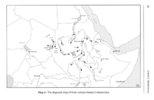This was meant to be post on sudanese reddit but I was having too many technical problems uploading it so I decide I'd drop it here, hope you guys find it valuable.
Also I always wanted an excuse t post this, so ig I found it, lol.

A bit of a catfish title ngl but I saw somebody make a post on asking about dinka history on relationship to ancient nubia and whatever and as a south sudanese admirer of nubian history who wanted to claim nubia but has researched this topic inside and out, I decided to make my comment a post which ill post here and on the south sudanese reddit for anyone else in the future or currently who may have had the same questions that I had, so hope this serves you well
it was pick like this that had 1st caught my interest, but I wanted to know more, lol

Disclaimer: You don't have to agree with me at all, frankly, I couldn't care any less. You are not forced to take whatever I say as genuine truth or anything. Im just a random Dinka guy who was really interested to try and learn about the history of his people. This is for the Sudanese (north & south) and anyone else who is interested in our origins/history and anybody else (africans obv, lol) who can relate to wanting to learn more about their own history but is working from limited resources.
Ngl I've talked with ppl about the origins of Dinka and nilotes for a while now, and although I don't think we have all the answers, I do think I came across enough things that Dinka people, nilotic people, and anyone interested in outr history could make good use of. It seems to me the especially in the last few years with the popularity of anti afrocentric sentiments going on the rise, any acknowledgement of nilote history that has to do w nubia especially has been always dismissed as "afrocentric" ideology and just wishful thinking. Especially with Somali nationalist movements as well people want to associate the history of sudan with "Cushitic people" who are "less african" in some ways and I notice this view take popularity w northern sudanese people who see south sudanese who want to connect with northern history as hoteps and are looking for a away to delegitimize or downplay and real connections with south Sudanese. Hence why, a lot claims about dinka living in northern Sudan, particularly the gezira for example, people like to bruh the topic off as "oral tradition" that is unreliable, yet they haven't actually read up on it to know how reliable they are in the 1st place, or to see that it actually in only based on oral tradition. So I'll break this comment down to a few sections. First the origins and migration history of the Nilotes and especially the Dinka, then 2nd will be cultural influences that Dinkas had specifically with the Nile Valley kingdoms (especially Alodia since it is the best documented) and also historical records.
Also I always wanted an excuse t post this, so ig I found it, lol.
A bit of a catfish title ngl but I saw somebody make a post on asking about dinka history on relationship to ancient nubia and whatever and as a south sudanese admirer of nubian history who wanted to claim nubia but has researched this topic inside and out, I decided to make my comment a post which ill post here and on the south sudanese reddit for anyone else in the future or currently who may have had the same questions that I had, so hope this serves you well
it was pick like this that had 1st caught my interest, but I wanted to know more, lol
Disclaimer: You don't have to agree with me at all, frankly, I couldn't care any less. You are not forced to take whatever I say as genuine truth or anything. Im just a random Dinka guy who was really interested to try and learn about the history of his people. This is for the Sudanese (north & south) and anyone else who is interested in our origins/history and anybody else (africans obv, lol) who can relate to wanting to learn more about their own history but is working from limited resources.
Ngl I've talked with ppl about the origins of Dinka and nilotes for a while now, and although I don't think we have all the answers, I do think I came across enough things that Dinka people, nilotic people, and anyone interested in outr history could make good use of. It seems to me the especially in the last few years with the popularity of anti afrocentric sentiments going on the rise, any acknowledgement of nilote history that has to do w nubia especially has been always dismissed as "afrocentric" ideology and just wishful thinking. Especially with Somali nationalist movements as well people want to associate the history of sudan with "Cushitic people" who are "less african" in some ways and I notice this view take popularity w northern sudanese people who see south sudanese who want to connect with northern history as hoteps and are looking for a away to delegitimize or downplay and real connections with south Sudanese. Hence why, a lot claims about dinka living in northern Sudan, particularly the gezira for example, people like to bruh the topic off as "oral tradition" that is unreliable, yet they haven't actually read up on it to know how reliable they are in the 1st place, or to see that it actually in only based on oral tradition. So I'll break this comment down to a few sections. First the origins and migration history of the Nilotes and especially the Dinka, then 2nd will be cultural influences that Dinkas had specifically with the Nile Valley kingdoms (especially Alodia since it is the best documented) and also historical records.

